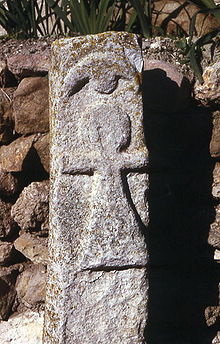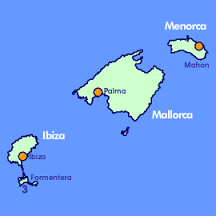Es Vedra
Tanit
 Tanit was a Carthaginian and Phoenician goddess. Immanuel Velikovsky claimed that the name of modern Tunis, near the site of Carthage, is a cognate of Tanit. She was also adopted by the Berbers and claims have been made that Tanit was also a Hyksos goddess.
Tanit was a Carthaginian and Phoenician goddess. Immanuel Velikovsky claimed that the name of modern Tunis, near the site of Carthage, is a cognate of Tanit. She was also adopted by the Berbers and claims have been made that Tanit was also a Hyksos goddess.
The Egyptian city of Sais where Solon first learned of Atlantis had it principal temple dedicated to the goddess Neith, whom the Egyptian priests identified with Athene. In turn, Neith is also associated with the Libyan goddess Tanit.
The whole matter of the relevance of Saïs to the Atlantis story has been challenged by the theory(a) that Saïs and Tanis, named after Tanit, were in fact the same location. A starting point is the fact that the current village of Sa el Hagar adjacent to the ruins of Saïs has a counterpart at Tanis where there is a village called San el Hagar. Drawing on the writings of Strabo, Herodotus and the Bible some have concluded that the two cities were one. Velikovsky also proposed this idea in his Ramses II and His Time[0832.209], noting that “Tanis is mentioned in Scriptures as the capital of Egypt when. according to both the conventional plan and this reconstruction, Saïs was the capital.”
The island of Es Vedra off the west coast of Ibiza, the third largest of the Balearics, has had a number of imaginative myths, old and new, associated with it, including one that it is supposed to be the birthplace of Tanit!
(a) https://h2g2.com/forums/A148907/conversation/view/F19585/T7572591/page/1/
Balearic Islands
The Balearic Islands in the Western Mediterranean is described by Britannica as consisting of two groups of islands. “The eastern and larger group forms the Balearics proper and includes the principal islands of Majorca (Mallorca) and Minorca (Menorca) and the small island of Cabrera. The western group is known as the Pitiusas and includes the islands of Ibiza (Eivissa) and Formentera.”
The archipelago was not occupied until  around 2200 BC. Although the two larger islands of Majorca and Minorca have many megalithic monuments, principally taulas and talayots, they have not, so far, been part of any serious Atlantis location theory. The only mention that I can find is the unsubstantiated claim by Frank Joseph [104.66] that the early settlers were invaders from Atlantis.
around 2200 BC. Although the two larger islands of Majorca and Minorca have many megalithic monuments, principally taulas and talayots, they have not, so far, been part of any serious Atlantis location theory. The only mention that I can find is the unsubstantiated claim by Frank Joseph [104.66] that the early settlers were invaders from Atlantis.
A February 2023 BBC article noted that “Menorca has one of the highest concentrations of prehistoric sites in the world (a selection of which are being considered for inclusion in Unesco’s World Heritage list in 2023). If the island is granted World Heritage status this year, it will unlock more funding for much-needed research that may help answer some of the mysteries of the taulas. It would also be a boon for cultural tourism, encouraging new visitors to explore this beautiful island with its unique archaeological heritage.” (h)
Steven Sora noted(d) that “From the Bible we know the Tartessians were ruled by kings and mentioned with princes of the isles—very likely islands like Corsica and the Balearics.” I mention this as Tartessos is frequently linked with Atlantis.
The island of Es Vedra off the west coast of Ibiza, the third largest of the Balearics, has had a number of imaginative myths, old and new, associated with it, including that it is supposed to be the birthplace of the goddess Tanit and the limestone on the island is alleged to have been used to build the Egyptian Pyramids. Then, for good measure, Es Vedra is also claimed to be a peak of the mountains of Atlantis!(c)
In 1911, Albert Gruhn proposed that Atlantis may have lain between the Balearics and Sardinia(a), while a century later the American nuclear engineer, Robert J. Tuttle, suggested[1148.301] the Balearics as a possible location when sea levels were lower and the archipelago was more extensive, explaining that “For Atlantis, we must relocate the ‘Pillars of Herakles’ to somewhere between Tunisia (the Roman ‘Africa’), Sicily and the toe of Italy”
In 2014, André Kramer published an illustrated paper(f) on the Mysteria 3000 website highlighting the existence of cart ruts on Mallorca, the principal island of the Balearic group. Kramer also identified cart ruts in Albstadt in Germany(g).
Gernot L. Geise has written a large number of articles about the megalithic monuments on the Balearics for EFODON‘s Synesis magazine(e).
The most recent discovery of a prehistoric stone structure on Menorca was reported in the Spring 2016 edition of Popular Archaeology magazine(b).
(a) https://paperspast.natlib.govt.nz/cgi-bin/paperspast?a=d&d=NOT19110819.2.22.16
(c) https://www.ibiza-spotlight.com/magazine/2013/07/legends-ibiza-es-vedra
(d) https://atlantisrisingmagazine.com/article/in-search-of-tarshish/ (offline May 2019)
In Search of Tarshish – ATLANTIS RISING THE RESEARCH REPORT (Page one only)
(e) https://www.efodon.de/html/publik/sy/sy.html
(f) Cart-Ruts auf Mallorca – Mysteria3000 (archive.org)
(h) https://www.bbc.com/travel/article/20230205-menorcas-mysterious-tables-for-giants *
